Webinar: Cyber fortification in healthcare against hybrid threats

It has long been predicted that wars would become hybrid, fought in multiple fronts at the same time, mixing conventional and irregular warfare with subversion, disinformation, and cyber-warfare. Following Russia’s invasion, Ukraine is facing constant cyber-attacks against its critical infrastructure. Viktor Zhora, deputy chairman of the State Service of Special Communications of Ukraine stated in early March 2022:
“These two wars [we are fighting] are part of this hybrid war. This is happening for the first time in history, and I believe that cyber-war can only be ended with the end of conventional war”, BBC, Ukraine says it is fighting first 'hybrid war' (https://www.bbc.com/news/technology-60622977)
With the advent of a threat model where the malicious acts stop being covert, and disruption is the key objective rather than blackmail, how can Europe’s critical healthcare infrastructure prepare and fortify itself against attacks of known origin and intent and stop them in their tracks? How can the process be sped up?
Who should attend this webinar?
We invite Hospitals and care centres, Medical Device manufacturers, ICT systems providers and Digital service providers to attend this webinar, where experts from three H2020 projects share their solutions.
- CUREX - (seCUre and pRivate hEalth data eXchange) - Enabling secure and authorized sensitive health data exchange. www.curex-project.eu
- PANACEA - (Protection and privAcy of hospital and health iNfrastructures with smArt Cyber sEcurity and cyber threat toolkit for dAta and people) – An integrated solution for cybersecurity in healthcare covering technology, people and processes. www.panacearesearch.eu
- SPHINX - (A Universal Cyber Security Toolkit for Health-Care Industry) - Enhancing the cyber protection of Health IT Ecosystem and ensuring the patient data privacy and integrity. www.sphinx-project.eu
AGENDA
| Duration (min) | Topic and Speaker |
|---|---|
| 10:00 - 10:10 |
Introduction and framework Overview | Christos Ntanos, National Technical University of Athens, Greece |
| 10:10-10:25 | Funding Opportunities in the Digtial Europe Programme, Cybersecurity for Healthcare | Wide Hogenhout, European Commission, Communications Networks, Content and Technology (DG CONNECT) |
| 10:25-10:40 |
CUREX presentation | Rodrigo Diaz-Rodriguez, Atos, Spain |
| 10:40-10:55 |
PANACEA presentation: Dynamic Risk Management Platform | Matteo Merialdo, RHEA, Belgium |
| 10:55-11:10 |
SPHINX presentation | Stylianos Karagiannis, PDMFC |
| 11:10-11:30 |
Interactive Panel Discussion | All Speakers |
| 11:30 | End of Webinar |
WATCH THE RECORDING
